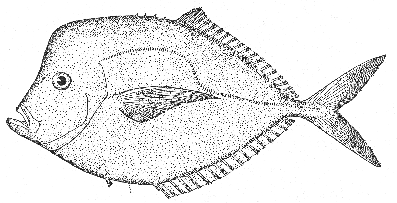Moonfish Vomer setapinnis (Mitchill) 1815
SHINER; HORSEFISH; BLUNTNOSE; DOLLARFISH
[Jordan and Evermann, 1896-1900, p. 934.]
Description—
The very deep, thin, sharp-edged body of the moonfish (adults are scarcely twice as long as deep, and young fry even deeper, relatively), tapering to a slender caudal peduncle, and the concave upper anterior profile of its head, are enough to separate it at a glance from pilotfish, scad, crevalle, hardtail, saurel, or goggle eye; its very low dorsal and anal fins distinguish it from the lookdown (p. 379), which is of something the same shape (cf. fig. 204 with fig. 205). Its minute ventral fins, soft dorsal fin and anal fin which are nearly even in height from end to end, separate it from the threadfin (p. 381), and from the Cuban jack (Hynnis cubensis), now thought to be the adult of the threadfin (p. 381).
The first dorsal of the adult moonfish is reduced to 8 very short, inconspicuous, detached spines, but the first two of these are prolonged and filamentous in young fry. Its second dorsal fin (21 to 23 rays) and its anal fin (17 to 19 rays) are about equal in length, both of them low and tapering very slightly from front to rear. In very small fish the second to fourth rays of the second dorsal fin are more or less prolonged, and the anal fin is preceded by 3 or 4 short detached spines which are not to be seen in the adult. The ventrals are so small that they are likely to be overlooked except in young fry, in which the ventral rays are more or less filamentous as are the dorsal spines. The pectorals are scythe shaped. The scales along the lateral line are not large enough to be conspicuous, and the teeth are very small. There are no detached finlets, dorsal or anal.
Color—
Bluish green above, bright silvery on the sides. The second dorsal fin is plain pale greyish, sometimes light yellow at its base; the [page 379] caudal is greenish yellow; the pectorals light yellow or dusky greenish.
Size—
Said to reach 1 foot in length, but most of them are less than 9 inches long.
General range—
Warm seas off the east coast of America from Uruguay to Cape Cod, straying to Nova Scotia; common from Chesapeake Bay southward.
Occurrence in the Gulf of Maine—
This waif from warmer waters has been recorded from the South Channel off Cape Cod (one specimen 1¾ inches long); off Cape Cod (60 miles south by east from Highland Light), where one was taken in a mackerel seine, August 23, 1929;[78] from Gloucester (several specimens); from Magnolia, Danvers, Salem, and South Boston (a specimen 2 inches long) around Massachusetts Bay; from Saco Beach (fry of about 1 to 3 inches); and from Casco Bay in Maine. It has even been reported once or twice as far east as Liverpool and Halifax, Nova Scotia.[79] Thus it appears to reach our Gulf rather more often than any of its relatives do; not often enough, however, for most of the fishermen of whom we have inquired to know it north of Cape Cod. It appears more often (if irregularly) at Woods Hole, where young fish are sometimes common in August and September.
